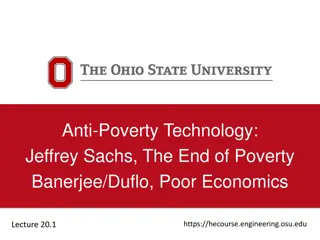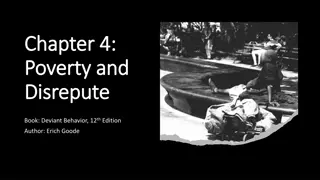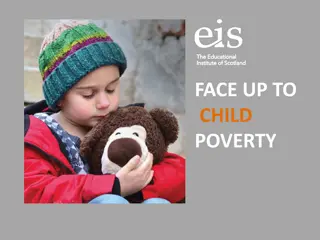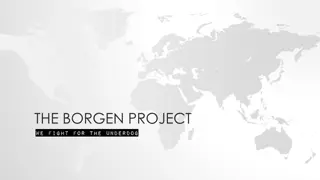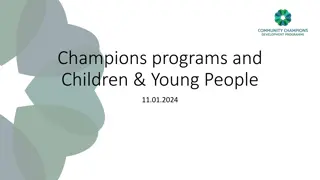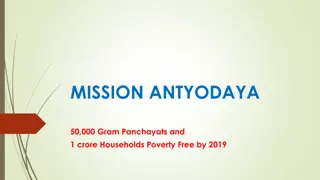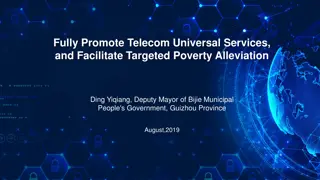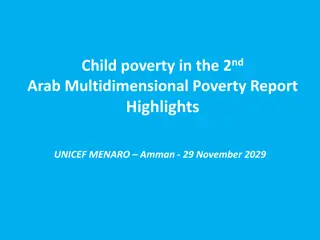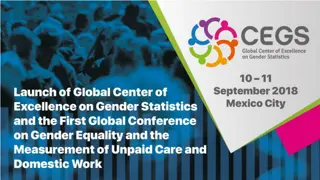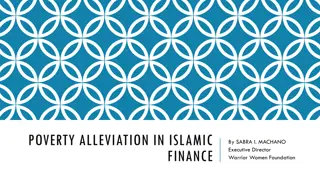Poverty Alleviation Programmes in India: A Historical Perspective
Poverty alleviation programmes in India have been a significant focus of government initiatives over the years. From the First Five Year Plan in 1951 to the Eleventh Five Year Plan in 2007, various schemes and efforts have been implemented to reduce poverty and improve the standard of living for those below the poverty line. Major programmes like the Integrated Rural Development Programme, Pradhan Mantri Gramin Awaas Yojana, and others have played a crucial role in addressing poverty in the country.
Download Presentation

Please find below an Image/Link to download the presentation.
The content on the website is provided AS IS for your information and personal use only. It may not be sold, licensed, or shared on other websites without obtaining consent from the author. Download presentation by click this link. If you encounter any issues during the download, it is possible that the publisher has removed the file from their server.
E N D
Presentation Transcript
COURSE: B.Sc. (PROGRAMME) IN ECONOMICS PAPER NAME BASIC FEATURES OF INDIAN ECONOMY TOPIC MAJOR POVERTY ALLEVIATION PROGRAMMES IN INDIA YEAR- SECOND SEMESTER-3 SESSION -2021-2022 DATE OF LECTURE: 5/10/2021 PREPARED BY DR. KAMALIKA CHAKRABORTY ASSISTANT PROFESSOR (DEPARTMENT OF ECONOMICS) KHATRA ADIBASI MAHAVIDYALAYA, BANKURA, WEST BENGAL
Poverty Alleviation Programmes aim to reduce the rate of poverty in India by providing proper access to food, monetary help, and basic essentials to the households and families belonging to who lie the below the poverty line. As per the Planning Commission of India, the level of poverty in a country can be estimated based on the consumer expenditure surveys that are conducted by the National Sample Survey Office (NSSO) under the Ministry of Statistics and Programme Implementation. Poverty Alleviation in India- Five Year Plans Eleven Five Year Plans were launched to eradicate poverty from India. The list of these Five Year Plans that started in the year 1951 is given below: First Five Year Plan (1951- 1956): The plan focused mainly on agriculture and irrigation and aimed at achieving an all-round balanced development. Second Five Year Plan (1956-1961): It focused on the growth of basic and heavy industries, expansion in employment opportunities, and an increase of 25 per cent in the national income. Third Five Year Plan (1961-1966): The Chinese aggression (1962), Indo-Pak war (1965), and the severest drought led to the complete failure of the third five-year plan. It was replaced by three annual plans that continued from 1966 to 1969.
Fourth Five Year Plan (1966-1974): It aimed at increasing national income by 5.5 per cent, creating economic stability, reducing inequalities in income distribution, and achieving social justice with equality. Fifth Five Year Plan (1974-1979): This plan mainly focused on the removal of poverty (Garibi Hatao) and aimed in bringing larger sections of the poor masses above the poverty line. It also assured a minimum income of Rs. 40 per person per month calculated at 1972-73 prices. The plan was terminated in 1978 instead of (1979) when the Janata Government came to power. Sixth Five Year Plan (1980-1985): Removal of poverty was the main objective of the sixth five-year plan with a major focus on economic growth, elimination of unemployment, self-sufficiency in technology, and raising the lifestyles of the weaker sections of the society. Seventh Five Year Plan (1985-90): The Seventh Five Year Plan aimed in improving the living standards of the poor with a significant reduction in the incidence of poverty. Eighth Five Year Plan (1992-97): This plan aimed at employment generation but later failed in achieving most of its targets. Ninth Five Year Plan (1997-2002): The ninth five-year plan focused on the areas of agriculture, employment, poverty, and infrastructure. Tenth Five Year Plan (2002-2007): The tenth five-year plan aimed at the reduction of the poverty ratio from 26 per cent to 21 per cent by the year 2007 and also to help the children in completing five years of schooling by 2007. Eleventh Five Year Plan (2007-2012): The eleventh five-year plan targets towards reducing poverty by 10 percentage points, generating 7 crore new employment opportunities, and ensuring electricity connection to all villages.
Major Poverty Alleviation Programmes in India Integrated Rural Development Programme (IRDP) [1978] Pradhan Mantri Gramin Awaas Yojana (1985) Indira Gandhi National Old Age Pension Scheme (NOAPS) [1995] National Family Benefit Scheme (NFBS) [1995] Jawahar Gram Samridhi Yojana (JGSY) [1999] Food for Work Programme (2000s) Sampoorna Gramin Rozgar Yojana (SGRY) Mahatma Gandhi National Rural Employment Guarantee Act (MGNREGA) [2005] National Food Security Mission (2007) National Rural Livelihood Mission (2011) National Urban Livelihood Mission(2013)
Major Poverty Alleviation Programmes in India (contd.) Pradhan Mantri Jan Dhan Yojana (2014) Pradhan Mantri Kaushal Vikas Yojana (2015) Saansad Aadarsh Gram Yojana (SAGY) (2014) Pradhan Mantri Jeevan Jyoti Bima Yojana (2015) Pradhan Mantri Suraksha Bima Yojana (2015) National Maternity Benefit Scheme (2016) Pradhan Mantri Ujjwala Yojana (PMUY) (2016) Pradhan Mantri Garib Kalyan Yojana (PMGKY) (2016) Solar Charkha Mission (2018) National Nutrition Mission (NNM), Poshan Abhiyan (2018)
Major Poverty Alleviation Programmes in India (contd.) Pradhan Mantri Shram Yogi Maan-Dhan (PM-SYM) (2019) Prime Minister Street Vendor s AtmaNirbhar Nidhi PM Svanidhi (2020)





